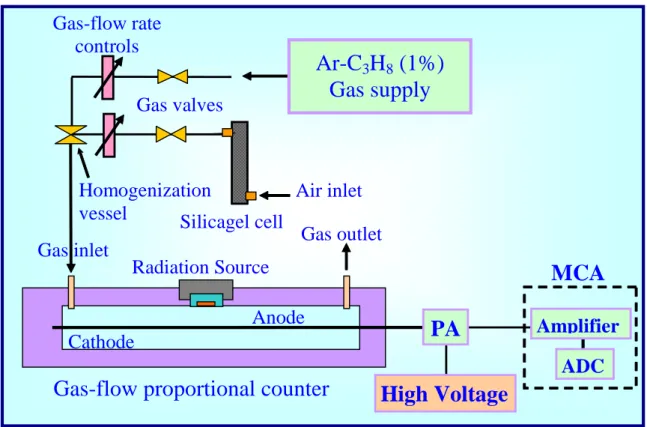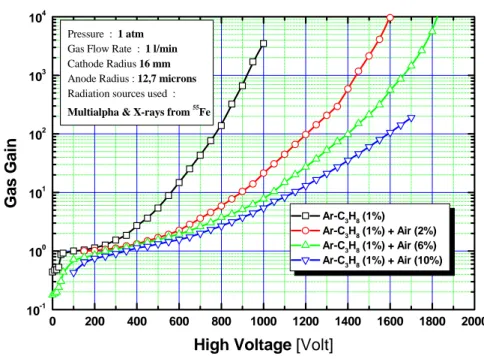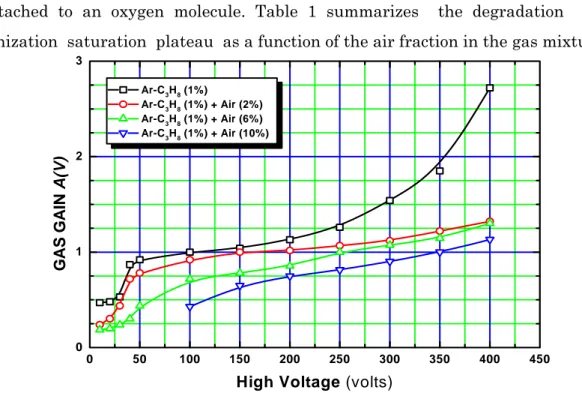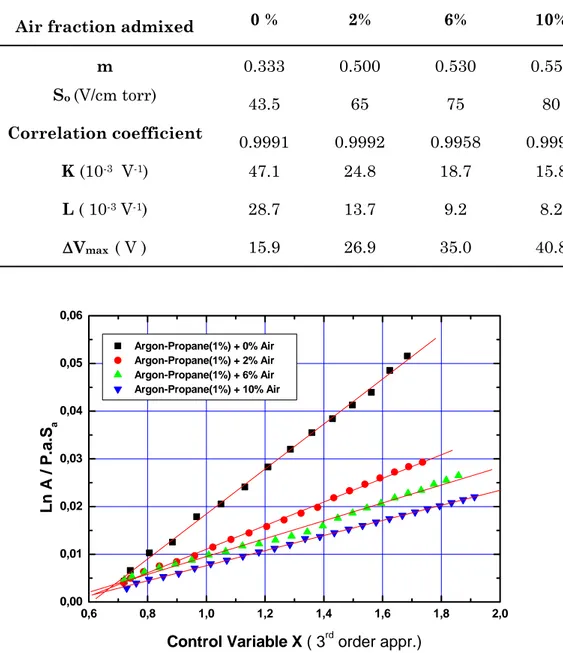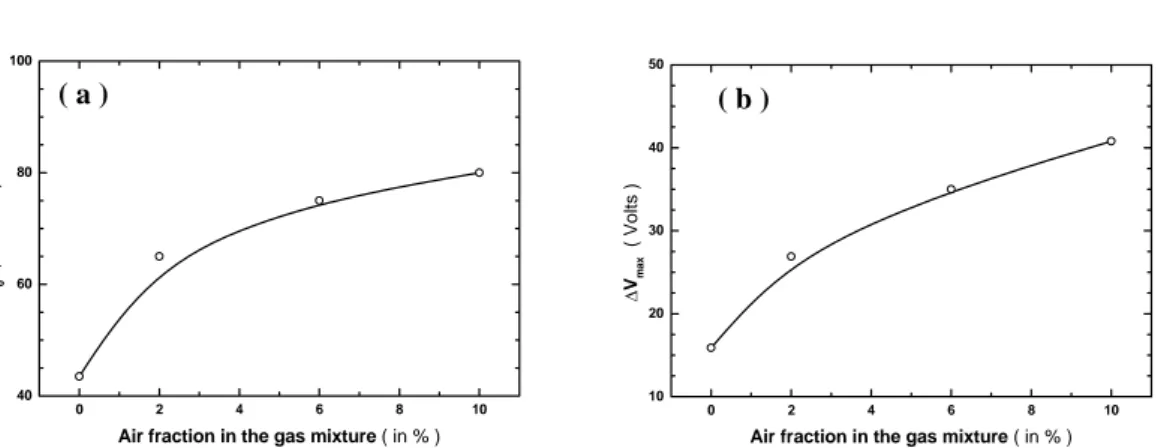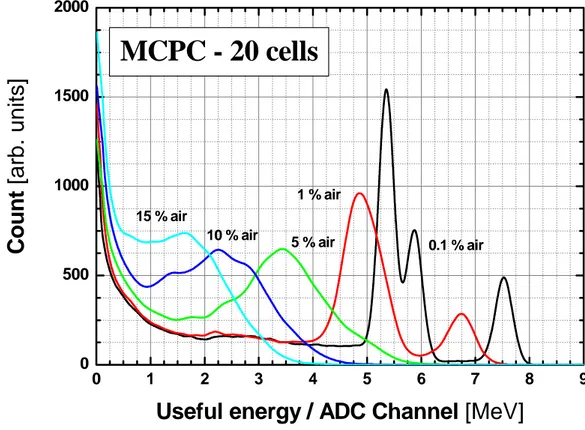S e c t i o n I I
The use of gas-filled detectors for radon activity
concentration measurement
1. Introduction
Radiation cannot be perceived by human senses. There are two basic types of instruments used for its detection: Particle counting instruments and Dose measuring instruments. With proper calibration, particle-counting instruments can be used to measure radiation. Internal dose can be deduced from measurements performed with particle counting instruments. Particle counting instruments are used to determine activity of a sample taken from the environment, to measure activity of body fluids, and can be used as portable survey instruments for contamination monitoring. The detector in a particle counting instruments can either be a gas, a solid or liquid. In all cases, passage of an ionizing particle through the detector results in energy dissipation through a burst of ionization. This burst of ionization is converted into an electrical pulse that actuates a readout device, such as a scaler or an ADC, to register a count in a channel corresponding to the signal amplitude. In the present research we are dealing with gas filled detectors. These devices look; in general purpose type, as a cylindrical condenser as sketched in figure 1. A central anode wire for collecting electrons is stretched along the axis of the cylinder, playing the role of cathode, for collecting positive ions. The ionising particle passes through the gas that fills the condenser, creating positive ions and electrons.
There are various types of particle counting instruments filled with gas: - Ionisation chamber counters (no secondary ions are produced)
- Proportional counters (secondary ions are produced but the number is proportional with initial energy of the radiation)
Figure 1 : A very simplified sketch of the gas filled-detector operation
- Geiger-Müller counters (secondary ions are produced in large numbers and the number of ions is no longer proportional with radiation energy)
The main difference between these 3 types of counters simply depends on the voltage used for charging the condenser.
In gas-filled detectors, since the electrical signal is provided by the collection of the primary electrons (and also secondary electrons, in case of gas amplifying devices : proportional counters, Geiger-Muller tubes..) and positive ions, one has obviously to use filling gases that have a very low electron affinity, in order to save the free electrons. Indeed, since the electrons move faster (about 1000 times) than the ions, one has to ensure that the free charge should be born by those fast particles (electrons), in order to get a device provided by a very fast time response and thus, achieving large range of measurable count rates (dynamic range). Therefore, the filling gas has to be free from gases such as air, due to its oxygen content, fluorine radicals, water vapour and so on.
2. Application to airborne radon monitoring
Radon (222Rn) is estimated to be responsible for about 30% of the whole human
radiation exposure. This radiation exposure is predominantly caused by the deposition on the respiratory tract and lungs of radon progenies through the aerosols taken in through respiration [1]. Radon also presents very particular properties: it is a radioactive noble gas and diffuses easily out of soils or building materials, spreading out in the environment. Consequently, different concentrations of radon and of its
progenies can be found everywhere around us. For this reason radon is an inescapable radiation exposure source both at home and at work. Since it is an inert gas, 222Rn does not react chemically with other atoms or molecules, making its chemical separation impossible and its physical trapping also difficult. Because of these facts, several detection systems and various measurement methods were developed in the past aiming for an accurate assessment of its activity concentration in air [2]. However, most of those methods present some practical limitations and generally they are not able to measure radon activity concentration on-line and/or are often affected by low detection efficiencies. Therefore, they do not provide the performance required in practice for an on-line measurement of medium radon activity concentrations (1 kBq m3–10 kBq m3). This feature is in fact of fundamental relevance for the study of the time variation of radon airborne activity concentrations and its equilibrium factors, especially when a correlation with environmental parameters is sought.
For this purpose, a design study of a new gas-flow proportional counter suited for such measurements was undertaken in our laboratory. As a first step leading towards the underlined aim and in order to assess the influence of air admixed to standard counting gases within proportional counters, we have investigated the properties of a proportional counter when using three typical air-mixed argon–propane (1%) gas mixtures [3]. It is the scope of this section to present the relevant experimental results obtained through this work.
For the design of a special gas-flow proportional counter intended for a new active
measurement method of airborne radon (222Rn) concentration, the amplification
properties of four gas compositions were investigated in air-mixed Argon-propane (1%)-based proportional counters [4]. These four gas compositions are: Ar-C3H8 (1%); Ar-C3H8 (1%) + 2% air; Ar-C3H8 (1%) + 6% air and Ar-C3H8 (1%) + 10% air. The influence of the electron attachment effect due to oxygen on the saturation and gas amplification characteristics was examined in particular. The semi-microscopic gas gain formula was found to describe accurately the gas gain data obtained in each of the gas mixtures analyzed allowing the determination of the gas constants. The use of air-mixed counting gases in a specially designed gas-flow proportional counter for airborne radon concentration measurements appeared quite viable.
3. The use of gas-filled detectors for radon measurement in ambient air
Few laboratories worldwide are focusing their research activity on the use of gas-flow proportional counters for the continuous monitoring of radon concentration in air. In fact, it is rather difficult to perform spectroscopy in open air, due to the presence of oxygen, water vapor and other electronegative gas traces. Nevertheless, some research groups have already made significant progress in this direction
[5,6,7,8,9,10,11] and some results are briefly reviewed below.
In 1992, Baltzer et al. [5] reported about a wire arrangement pulse-counting ionization chamber for measuring radon concentration in atmospheric air. Their device was based on both positive and negative ion collection (due to electron attachment) and it is severely limited by the excessively long collection times involved. The authors have also noticed the existence of an important microphonic noise, which could be generated by the wire structure vibrations. Klein et al. [6] mentioned the possibility of using proportional counters for in situ radon level characterization, but gave no more details. Zikovsky [7] tried to measure radon concentrations in air by performing alpha counting of the 218Po and 214Po products deposited on the inner walls of the counter. He first filled a proportional counter with an air sample and then evacuated the counter after periods of time between 30 and 216 min, immediately introduced P-10 gas, a standard counting gas (argon–methane (90–10%)), to detect the alphas emitted by the radon decay products. Unfortunately, in addition to the fact that this method cannot provide on-line measurements, it has also a major drawback of fundamental importance: the equilibrium factors are not exactly known [8]. In order to make on-line medium-level measurements of radon activity, Rottger et al. [9] also used a multi-wire pulse ionization chamber, similar to the one described by Baltzer. Their device was designed to permit adequately large volumes (from 5 to 13 l) and presented a special electrode configuration (Archimedean spiral layout). However, the device is still based on ion collection and, since the electrons are captured by electronegative gases, e.g., oxygen, only positive and negative ions are suitable for collection in pulses. This results in very low amplitude and long-current pulses of about 1 fA in 30 ms [10]. Therefore, this multi-wire pulse ionization chamber is naturally subjected to some limitations such as long collection times and residual microphonics noise.
Recently, Busch et al. [11] reported on the first use of a gas-flow proportional counter for performing direct radon activity concentration measurements. However, the gas-flow proportional counter used does not carry out radon measurement in ambient air, but uses the P-10 gas as a suitable counting gas to which radon gas emanating from a radium source is directly mixed.
Therefore, it follows that, to the best of our knowledge, no attempt was reported about the use of gas-flow proportional counters specifically dedicated to measure on-line radon activity concentration in air by counting the alpha particles emitted by 222Rn itself. If the objective is to assess sudden radon concentration variations in time delays as short as possible, especially when a correlation with environmental parameters is sought, it is more convenient to count only the alphas emitted by decaying radon nuclides, avoiding the subsequent time delays necessary for the alpha activity of the radon progenies to become high enough to be significantly measurable. Therefore, this feature would imply that the counter sensitive volume must be filled partly, if not wholly, by a certain fraction of the air sample to be monitored. This prompted us to make a preliminary investigation of the effect of air on some practical properties of air-mixed counting gases in proportional counters, such as the ionization saturation, and particularly by focusing our attention on the gas amplification characteristics.
The gas amplification process has been already extensively studied in air-free counting gas mixtures in several proportional counters [12]. However, we believe that it is quite possible to use air-mixed counting gases as sensitive media in gas-filled counters even when they operate precisely in the proportional region. Thereby, the admixed air component will act primarily as a subsequent quenching gas, through its nitrogen content, providing thus a more stable proportional regime and, at the same time, will constitute the air sample in which radon activity concentration has to be monitored.
In the present paper, we investigate four gas compositions. The first gas mixture examined is air-free argon–propane (1%) to which, thereafter, we successively admixed 2%, 6% and 10% of ambient air, in order to assess the effect of air on the proportional counter regime. We chose the air-free argon–propane (1%) gas mixture as the main counting gas for two reasons: the argon stopping power for alpha particles is
high enough to shorten efficiently the alpha ranges, reducing therefore the wall effect, and argon is available at a low cost. As a quenching gas, we adopted propane with a fraction of 1%. Indeed, this fraction is sufficient to ensure an efficient absorption of the UV photons emitted during the de-excitation of exited argon atoms, and thus allows to achieve a stable proportional regime operation of the counter.
4. The electron attachment effect in air-mixed counting gases
When operated in the ionization regime, air-filled detectors deliver very small electric pulses characterized by strong pulse height fluctuations and very long ion collection times. Because of the presence of electronegative gases, electron collection-based air-filled ionization chambers cannot be used for the purpose in concern. The electron attachment by oxygen contained in air will reduce drastically the number of the primary electrons produced within the sensitive volume of the counter and, consequently, a reliable linear response of the counter versus the actual alpha activity becomes difficult to achieve in practice. Indeed, when released in the sensitive volume of gas-filled detectors, primary electrons undergo well known elastic and inelastic processes [13]. Among these processes, one has to consider carefully the electron attachment by electronegative molecules such as oxygen, especially in the case when an important fraction of this gas, contained in atmospheric air, is intentionally admixed to the main counting gas. The electron attachment effect is well known, both fundamentally [13-14] and regarding its practical implications for gas-filled detectors such as ionization chambers, proportional counters, drift chambers [15-16], etc.
When using a proportional counter, a number of those primary electrons not captured by electronegative molecules will reach the anode wire where they are
amplified up to 103 times by the high voltage applied. In this way, the electron
attachment effect can be compensated by the gas amplification mechanism, although only to a limited level [16].
5. The gas amplification compensation
In proportional counters, we can identify two main evolving regions: the drift space region and the gas amplification region; the latter is also called Townsend avalanche region. In the former, the electric field-to-gas pressure ratio, S(r)=E(r)/P, is characterized by rather low values, typically not higher than 35–45 V cm-1 Torr-1. The primary electron energy is always lower than the first ionization potential of the main
filling gas and there is no electron multiplication. However, the electron attachment, because of the lower values of S(r), has throughout this region such a considerable effect that even the detection process of the counter could be totally compromised. In contrast, within the Townsend avalanche region, S(r) has generally sufficiently high values, such that a large fraction of the avalanche electrons can ionize the gas and create further electrons along their last transit step, just before reaching the anode wire. Therefore, in this region the influence of electron attachment should be considerably less, due to the shorter distances traveled by the avalanche electrons, typically only 5–10 times the wire radius, and also the higher energies gained by the avalanche electrons. This is illustrated in Figure 2, which shows the electron-energy dependence of the dissociative electron attachment cross section of the oxygen molecule: the electron attachment cross section is quite negligible for electrons of energy higher than 9 eV, which are predominant in the avalanche region. Consequently, one can expect that the electron attachment process will introduce only a negligible effect on the gas amplification characteristics of the proportional counter, even in the presence of an important fraction of electronegative gas molecules as in our present case (up to 10% of air, corresponding approximately to an oxygen concentration of about 21000 ppm). 2 3 4 5 6 7 8 9 10 11 12 0,0 0,5 1,0 1,5 2,0
from L.G.Christophorou et al. , ref. [13] OXYGEN ( O2 ) Si gm a da (10 -18 cm 2 )
Electron energy (eV)
Figure 2: The electron energy dependence of the dissociative electron attachment cross section of oxygen (experimental data taken from[13]).
Since it was pointed out that the yet existing gas amplification models were not well founded theoretically, in order to assess accurately the gas amplification of the electrons released within the sensitive medium of proportional counters, we were lead to develop a semi-microscopic model.
In cylindrical single wire proportional counters, the electron avalanche development in the vicinity of the anode wire can be described only by the first Townsend coefficient , if the accompanying effects can be neglected such as:
• the charge recombination and the space charge effects, • the photoionization process and the photoelectric effect, • the electron extraction through ionic impacts,
• the Penning effect and other three bodies processes. The gas gain, A, is then simply expressed by
⎟⎟
⎠
⎞
⎜⎜
⎝
⎛
=
∫
a cdr
A
exp
α
(1)where a is the anode radius and c the starting point of the gas amplification process. Since /P is assumed to be a function of S only, it is more convenient to express the gas gain by the relation, known as the gas gain equation, given by [17]
dS
S
P
S
a
P
A
Ln
a c S S a 21
∫
=
α
(2)where Sa and Sc are, respectively, the electric field strength to pressure ratio at the
anode wire surface and at the avalanche starting point rc , given by
)
/
(
b
a
Ln
a
P
V
S
a=
and)
/
(
b
a
Ln
r
P
V
S
c a=
where V is the applied voltage, P the total gas pressure in the counter and a and b are, respectively, the anode and cathode radii.
Using the derived semi-microscopic /P form given by [18] :
⎥
⎥
⎦
⎤
⎢
⎢
⎣
⎡
⎟
⎠
⎞
⎜
⎝
⎛
−
Δ
=
+mS
S
V
S
P
1 0 maxexp
α
(3)where ΔVmax , S0, and m are constants related uniquely to the gas properties, we
deduce the semi-microscopic gas gain formula, developed up to its 3rd order
approximation. It is expressed as follows :
(
)
( ) ( ) ( ) L S S S S S S S S Ln m K S a P A Ln m a m a m a a a − ⎥ ⎥ ⎦ ⎤ ⎢ ⎢ ⎣ ⎡ ⎟⎟ ⎠ ⎞ ⎜⎜ ⎝ ⎛ ⋅ + ⎟⎟ ⎠ ⎞ ⎜⎜ ⎝ ⎛ ⋅ − ⎟⎟ ⎠ ⎞ ⎜⎜ ⎝ ⎛ ⋅ + ⎟⎟ ⎠ ⎞ ⎜⎜ ⎝ ⎛ + = + + + 31 0 1 2 0 1 0 0 3 3! 1 ! 2 2 1 ! 1 1 1 1 (4) ,The constants S0, m, K and L characterize the physical nature of the gas mixture
inside the counter and are determined on the basis of a suitable fitting analysis of the experimental set of gas-gain data at hand. The expression in brackets of Eq. (4), which depends on external, physical and electrical parameters and on the gas mixture nature, is called here the control variable and is denoted by X. When the left-hand side term of Eq. (4) is plotted versus the control variable X, a straight line should be obtained. Then, by least squares fitting method, the constants K and L are easily determined. The physical significance of the gas constants and also the whole method used for the determination of the primary gas constants m and S0, are sufficiently
discussed in our previous contributions [18-19], where a practical form of the gas-gain semi-microscopic formula was suggested. One recalls that m is identified as the moderation parameter, and its value is closely related to the shape of the cross-sections of the major inelastic processes involved; S0 is interpreted as the critical
value of the electric field to pressure ratio for which the gas amplification process starts up and its value is also connected to the moderation parameter m. We can also deduce another more explicit gas constant, ΔVmax , given by:
(
m
)
K
V
+
=
1
1
maxΔ
(5).This can be interpreted as the maximum potential difference travelled by an avalanche electron between two successive ionizing collisions. By studying the gas constants values of the air-mixed argon-propane (1%) mixtures, one can assess better the net effect of the air on the amplification properties, in order to choose the most suitable composition for the above-mentioned purpose.
6. Experimental set-up and procedure
The proportional counter used for the gas-gain measurements is a sensitive 16 cm length stainless-steel-made gas-flow proportional counter with a 0.001 in. diameter (25.4 m) tungsten wire and a 32 mm diameter cathode tube. The counter was
operated at atmospheric pressure and room temperature (296 K). The gas-flow rate was set at 1 l/min and kept constant during the whole measurements (its fluctuations do not overpass 1% of the indicated values). The counter and the gas mixture manifold are shown in Figure 3. A silica gel cell is inserted in the air circuit in order to remove the water vapor excess evenly present in the atmospheric air and then prevents high humidity contents air samples. The radiation source was placed directly inside the counter, on the cathode surface at the midpoint of the tube, limiting thus the so-called “end effects”, i.e., the perturbation of the 1/r electric field, resulting in a local reduction of the gas-gain value. Two radiation sources were used: a multi- source formed by a mixture of 239Pu, 241Am and 244Cm radioisotopes, for low- and medium- gas-gain levels; we used 55Fe radioisotope emitting 5.9 keV X-rays for higher gas-gain values, avoiding excessive space charge accumulation around the anode wire.
First of all, we examined the amplification characteristics in the argon–propane (1%) counting gas mixture free from air, then we added 2%, 6% and 10% of atmospheric air. For each of these gas mixtures the amplification characteristics were measured. The electron collection pulse signals delivered by the proportional counter were fed into a low-noise charge-sensitive preamplifier (ORTEC 142 PC). The
Gas outlet
Radiation Source
Anode
Cathode
MCA
Gas inlet
Gas-flow proportional counter
Homogenization
vessel
Air inlet
Gas-flow rate
controls
Silicagel cell
Ar-C
3H
8(1%)
Gas supply
Gas valves
ADC
Amplifier
High Voltage
PA
preamplifier output is in turn fed into the built-in amplifier of the MCA (Silena, SNIP 204G). The pulse shaping time was fixed at 2 s and the amplifier gain was varied according to the pulse height delivered by the preamplifier. Typically, two amplifier gain settings were used: 200 and 10. A gain of 200 was chosen when very low amplitude signals from the preamplifier were processed, i.e., when the counter operates in the ionization chamber regime and also when it operates at low gas-gain values in the proportional regime. A down-shift to gain 10 was adopted for a higher gas-gain operation. The experimental gas-gain measurement method we used is based on the pulse technique that was fully described previously [20]. It consists in the measurement of the channel number corresponding to the main peak in the spectrum as a function of the high voltage value. At low gas-gain values, when using the multi-alpha source, the gas gain A(V) at the set voltage V is simply computed by
( )
α α αα V S SG
G
N
V
N
V
A
=
(
)
(6) ,where,NSαis the channel number of the alpha reference peak when the counter
operates at the saturated ionization chamber regime and N (V) is the channel number of the same peak at the set value V of the high voltage, whereas, α
S
G and
G
Vα are theamplifier gain respectively in the saturated ionization chamber regime and when the counter is operated at the high voltage V, using the multialpha radiation source. At higher voltage values, we replaced the multialpha source by the 5.9 keV X-ray 55Fe source, the gas gain A(V) was computed by:
( )
α α α αW
W
E
E
G
G
N
V
N
V
A
X X X V S S X)
(
=
(7),where, NX (V) is channel number corresponding to the 5,9 keV peak recorded for the
high voltage V, X V
G is the adopted amplifier gain when the counter was polarized at
voltage V, whereas, EX and Eα are the energy expended by the ionizing radiation (X
and α , respectively) in the sensitive gas. WX and Wα are the energies necessary for
one electron-ion pair production in the sensitive gas mixtures respectively by X-ray photons and by α particles. However, we neglected the small differences that exit between the two values, and set the ratio (WX /Wα) equal to unity. Indeed, according to
unity whereas, in the case of air-filled detectors the difference that arises between WX
and W is not greater than 5%. Therefore, this leads us to conclude that in our present case the maximal error we introduce when setting the W ratio equal to unity should likely not exceed 1% in the extreme case (10% air).
On the other hand, since the uncertainty in the peak channel number determination is about 1%, an error propagation analysis, based on Eqs. (4) and (5), ascertains that the experimental gas-gain data are evaluated with a precision better than about 3%. Consequently, this allows us to conclude that the cumulated error made in the fitting analysis and gas constants determination should not be greater than 5%, which is considered sufficient for our present purpose.
7. Experimental results and discussion
For each gas mixture examined, plotting the gas amplification characteristic A(V) (see figure 4), we can notice the important effect of air admixture. Using the Ar–C3H8 (1%) free from air and setting the high voltage to about 800 V, it is possible to achieve
0 200 400 600 800 1000 1200 1400 1600 1800 2000 10-1 100 101 102 103 104 Pressure : 1 atm Gas Flow Rate : 1 l/min Cathode Radius 16 mm Anode Radius : 12,7 microns Radiation sources used :
Multialpha & X-rays from 55Fe
Ar-C3H8 (1%) Ar-C3H8 (1%) + Air (2%) Ar-C3H8 (1%) + Air (6%) Ar-C3H8 (1%) + Air (10%) Gas Ga in
High Voltage [Volt]
Figure 4: Measured (symbols) and calculated (solid lines) of gas amplification characteristics in air-mixed argon-propane (1%) based gas-mixtures.
a gas gain of about 100. But, the addition of just 2% air requires to increase the high voltage up to 1200 V to recover the same level of gas gain. For 6% air admixture, a gas gain of 100 is achieved at a voltage of about 1400 V, and when 10% of air is admixed, the high-voltage value must be set at 1600 V, twice the value used in air-free Ar–C3H8 (1%). This is expected, since the electrons need much more energy to compensate the losses suffered through inelastic collisions, which they increasingly undergo during their avalanche process in the presence of air. In other words, increasing the voltage value has the effect of preserving the total number of avalanche electrons able to produce subsequent secondary electrons, at nearly the same fraction as in the case of air-free Ar–C3H8 (1%) gas mixture.
The effect of the electron attachment, particularly predominant in the drift space, can be noticed in Figure 5, which enlarges the recombination region and the saturated ionization chamber regime. We can notice that the electron attachment effect results in an increased catastrophic degradation of the ionization saturation characteristics. This translates into a progressive increase of the saturation plateau slope as the air fraction in the mixture is increased from 0% to 10%. For a given high-voltage value, this effect can be foreseen since the greater the oxygen fraction in the gas mixture , lower the number of primary electrons that cross the drift space without being attached to an oxygen molecule. Table 1 summarizes the degradation of the ionization saturation plateau as a function of the air fraction in the gas mixture.
0 50 100 150 200 250 300 350 400 450 0 1 2 3 Ar-C3H8 (1%) Ar-C3H8 (1%) + Air (2%) Ar-C3H8 (1%) + Air (6%) Ar-C3H8 (1%) + Air (10%) GAS GAI N A( V)
High Voltage (volts)
Figure 5: Evolution of the saturation plateau slope in air- mixed argon-propane (1%) based
TABLE I : The gas gain constants obtained from the fitting analysis of the measured gas gain data in Ar-C3H8 (1%) and air-mixed Ar-C3H8 (1%)-based proportional counters.
Air fraction admixed 0 % 2% 6% 10%
Saturation Plateau Slope (% / 100 V) 8 10 14 19 0,6 0,8 1,0 1,2 1,4 1,6 1,8 2,0 0,00 0,01 0,02 0,03 0,04 0,05 0,06 Argon-Propane(1%) + 0% Air Argon-Propane(1%) + 2% Air Argon-Propane(1%) + 6% Air Argon-Propane(1%) + 10% Air Ln A / P .a. Sa
Control Variable X ( 3rd order appr.)
Figure 6: The fitting curves of the 3rd order approximation of the semi-microscopic formula
to the gain data in the examined air-mixed Ar-C3 H8 (1%)–based gas mixtures.
TABLE II: The gas gain constants obtained from the fitting analysis of the measured gas gain data in Ar-C3H8 (1%) and air-mixed Ar-C3H8 (1%)-based proportional counters.
Air fraction admixed 0 % 2% 6% 10%
m 0.333 0.500 0.530 0.550 So (V/cm torr) 43.5 65 75 80 Correlation coefficient 0.9991 0.9992 0.9958 0.9997 K (10-3 V-1) 47.1 24.8 18.7 15.8 L ( 10-3 V-1) 28.7 13.7 9.2 8.2 ΔVmax ( V ) 15.9 26.9 35.0 40.8
By increasing slightly the high-voltage value (hence the electric field to pressure ratio applied on the anode wire surface), the electron energy distribution function in the drift space is shifted a little more to the higher energy side, thus resulting in a reduction of the electron attachment rate within the drift space, since this effect is chiefly predominant at lower electron energies. Therefore, the fraction of collected electrons tends to be restored again, even with negligible gas gain compensation.
The gas amplification characteristics are studied using the semi-microscopic formula given by Eq. (1). Linear fitting curves from this formula for measured gas-gain data are shown in Fig. 6. As expected, the third-order approximation of this equation describes well the obtained gas-gain data, despite the important electron attachment effect due to the high oxygen fraction in the gas mixtures. The computed correlation coefficient of the fittings is greater than 0.99 in all cases and a value of 0.9997 is even achieved in case of Ar–C3H10 (1%)+10% air. The obtained gas constants are summarized in Table 2. The value taken by the moderation parameter m increases from 0.33 to 0.55 when raising the air fraction in the gas mixture. This trend is nearly the same for S0, the critical value for the gas amplification onset.
These data can be interpreted considering that the raise in air fraction contributes to an increase in the mean fraction of the total energy that the electrons lose through inelastic non-ionizing collisions. As a result, the electron temperature in the avalanches decreases (cooling effect or moderation effect). This determines a slight increase of the parameter m. The energy losses through inelastic collisions are mainly expended to excite the vibration and optical states of nitrogen and oxygen molecules of the air mixed in the main gas with an increasing fraction. On the other hand, the
increase of S0, shown in Fig. 7-a, means that the volume of the avalanche space
narrows and collapses around the central wire. Therefore, this results in a reduction of the gas gain for a fixed value of the high voltage. This effect appears also in Fig. 7-b, showing the evolution of the maximum potential difference Vmax traveled by an avalanche electron between two successive ionizing collisions. Indeed, in order to maintain almost the same gas-gain operation level, when we admix up to 10% of air to the counting gas mixture, the avalanche electrons have to travel a potential distance about 2.5 times greater than they do if the argon–propane (1%) gas mixture is free from air.
What concerns us now is the electron attachment effect in argon–propane (1%)+10% air. We remark that even with the presence of an oxygen concentration of about 21,000 ppm in the mixture the proportional counter continues to operate rather well, and the gas amplification mechanism plays a decisive compensation role, remedying the electron attachment effect.
This is consistent with the experimental results reported by Zikovsky [7]. Indeed, while studying the effect of an occasional air contamination, he admixed an air fraction of about 10.5% with P-10 gas used in his proportional counter and he was still able to count alpha particles although with an efficiency of about 2%, even though his counter had a cathode radius (7.6 cm) about 4.8 times larger than ours. This means that the electron attachment rate in his counter should be correspondingly larger than ours, due to the fact that the drifting electrons have to travel larger distances to reach the gas amplification region. Therefore, in order to reduce the influence of the electron attachment effect, one has to design the proportional counter in such a way that the primary electrons have to cross-minimal drift distances. In this way, as was clearly shown by Andronic et al. [22], the O2 content of the gas will affect the collected charge only to a small extent. In the light of these primary results, and especially from the gas amplification point of view, we can conclude that the possibility of use of air-mixed counting gases in a suitably designed gas-flow proportional counter for performing on-line measurement of airborne radon activity concentration appears quite viable. 0 2 4 6 8 10 40 60 80 100 S0 (V /cm.t o rr)
Air fraction in the gas mixture ( in % )
0 2 4 6 8 10 10 20 30 40 50 Δ Vma x ( Vo lt s )
Air fraction in the gas mixture ( in % )
Figure 7: Evolution of the gas constants S0 (a) and ΔVmax (b) in air-mixed
Ar-propane(1%)-based gas mixtures as a function of the admixed air fraction. ( b )
8. Applicability for radon measurements and achievable sensitivity
Following this purpose, a special air-mixed gas-flow proportional counter is designed and constructed. The designed counter, called Multiple Cell Proportional Counter (MCPC), is characterized by a relatively good flexibility and a sufficiently large sensitive volume of about 10 liters. It is composed by an assembly of 20 cylindrical cell elements, each of them having a height 3 cm and a diameter 16 cm. Every single cell consists of a cathode mesh plane and an anode wire plane separated by an electrode distance of 1.5 cm. The anode plane is constituted by a parallel array of interconnected thin wires. The design, operation, and Monte Carlo simulation of the MCPC is detailed forward ahead in this thesis. In order to carry out a number of design optimization studies and to make an estimate of the applicability of this technique for radon measurements, a Monte Carlo simulation code was written and further details were presented [23,24].
0 1 2 3 4 5 6 7 8 9 0 500 1000 1500 2000
MCPC - 20 cells
10 % air 15 % air 5 % air 1 % air 0.1 % airC
ount
[arb. units]
Useful energy / ADC Channel [MeV]
Figure 8: Monte Carlo simulation of the expected alpha pulse height spectra
(area-normalized) as the air fraction is increased in argon–propane (1%) counting gas used in the designed MCPC. The integral 1/E-type background count rate is assumed to be 5 counts/min.
As should be seen in next sections, according to these results, the admixture of 10% to the main argon–propane (1%) counting gas is found sufficient to assess stepwise airborne radon activity concentration as low as 15 Bq/m3 for a counting time period of 10 min, with an energy-equivalent discrimination threshold of 0.250 MeV, resulting in an expected radon activity concentration sensitivity of about 1.16 cpm/10Bq/m3. As an illustration, in Figure 8 is depicted the Monte Carlo calculation of the expected alpha pulse height spectra (area-normalized) as the air fraction is increased from 0.1% to
10% in argon–propane (1%) gas mixture used in the designed MCPC. The 222Rn
activity concentration in air is assumed stepwise: it jumps from zero to a constant value at t = 0, and remains at this value for at least 10 min. The alpha pulse height spectra collection is started at t = 0 for a time duration of 10 min. The simulated spectra for air fractions of 0.1%, 1%, 5% and 10%, are then area normalized in order to show the net effect of air on the alpha pulse height distributions. It can be seen from Fig. 8 that with admixture of 10% of air, although the designed MCPC can no longer discern between the alpha particles originating from 222Rn (5.489 MeV) and from 218Po (6.002 MeV), it still allows to perform a correct alpha counting if a convenient setting of the energy-equivalent discrimination threshold is adopted. Therefore, this tends to confirm furthermore the consistency of the described active method to measure on-line radon activity concentrations.
9. Conclusions
To achieve more reliable on-line measurements of airborne radon concentration using gas-filled detectors based on spectrometry technique, it is required to perform the measurement of the radon activity within the sensitive volume by counting directly the alpha particles emitted by decaying radon nuclides. Especially, if the scope is to assess sudden radon concentration variations in time delays as short as possible, it is recommended to count only the alphas emitted by decaying radon nuclides, avoiding subsequent time delays, before the alpha activity of the radon progenies becomes significantly measurable. This implies the need to mix the counting gas with a small fraction of the air sample to be monitored. Hence, the air sample becomes intrinsically a component of the sensitive gas mixture. The presence of oxygen, a highly electronegative gas, introduces serious problems related, in particular, to the attachment effect causing an excessive electron charge loss within
the drift space. However, the electron attachment effect can be counterbalanced by subsequent gas amplification when using suitably designed proportional counters.
In this section, the gas amplification characteristics of three air-mixed argon– propane (1%)-based gas mixtures were studied. Our results show that by mixing the counting gas with a fraction of air up to 10%, the attachment effect does not introduce a critical perturbation within the gas amplification region, but only affects the charge collection process within the drift space of the proportional counter. Hence, it seems quite possible to reduce the electron losses by designing special proportional counters which minimize the drift space dimensions. The presence of a fraction of air as high as 10% does not seem to penalize excessively the detection process if an appropriately designed gas-flow proportional counter is used, and this is confirmed by the preliminary results obtained from a Monte Carlo simulation study.
HIHIHIHI
References
[1] J. Porstendorfer , T.T. Mercer, “Adsorption probability of atoms and ions on
particle surfaces in submicrometer size range”, J. of Aerosol Science, Vol. 9 (1978) 469-474.
[2] A.C. George, “An overview of instrumentation for measuring environmental Radon
and Radon progeny”, IEEE Trans. on Nucl. Sci., Vol.37, n°2, (1990) 892-901. and also : A. George, State-of-the-art instruments for measuring radon/thoron and their progeny in dwellings—a review, Health Phys. 70 (1996) (4), pp. 451–463.
[3] G. Curzio, D. Mazed, R. Ciolini, A. Del Gratta, A Gentili, “Effect of air on gas
amplification characteristics in argon-propane (1 %)-based proportional counters for airborne radon monitoring”, Nucl. Instr. and Meth., A 537 (2005)672-682.
[4] D. Mazed, R. Ciolini, “Gas gain in air-mixed argon propane (1%) based
proportional counters”, Communication presented at the 11th International
Congress of the International Radiation Protection Association, IRPA’11, May 23-28, 2004, Madrid, Spain.
[5] P. Baltzer, K.G. Gorsten, A. Backlin, “A pulse counting ionization chamber for
[6] D. Klein, R. Barillon, S. Demongeot, E. Tomasella, A. Chambaudet,“Investigative
techniques for Radon Level characterization”, Rad. Meas.,Vol. 25, n°1-4 (1995)553.
[7] L. Zikovsky, “Determination of Radon-222 in gases by alpha counting of its decay
products deposited on the inside walls of a proportional counter”, Rad. Meas., Vol.
24, n° 3 (1995) 315-317.
[8] A. Honig, A. Paul, S. Rottger, U. Keyser, “Environmental control of the German
radon reference chamber”, Nucl. Instr. and Meth., A416 (1998) 525-530.
[9] S. Rottger, A. Paul, A. Honig, U. Keyser, “On-line low-and medium-level
measurements of the radon activity concentration”, Nucl. Instr. and Meth., A466 (2001) 475-481.
[10] A. Paul, A. Honig, D. Forkel-Wirth, A. Mueller, A. Marcos, “Traceable
measurements of the activity concentration in air”, Nucl. Phys. A, 701 (2002) 334c
[11] I. Busch, H. Greupner, U. Keyser, “Absolute measurement of the activity of 222Rn
using a proportional counter”, Nucl. Instr. and Meth., A481 (2002) 330-338.
[12] D. Mazed, Magister Thesis, no 13/2002/MPH, University of Sciences and Technology Houari-Boumediène, Algiers, February 2002 (unpublished).
[13] L.G. Christophorou, J.K. Olthoff, “Electron interactions with plasma processing
gases present status and future needs”, Appl. Surf. Sci.,vol.192 (2002) 309-326.
[14] J.D. Skalny, S. Matejcik, T. Mikoviny, J. Vencko, G. Senn, A. Stamatovic, T.D.
Mark “Absolute calibration of relative electron attachment cross section by crossed beams experiments”, Int. J.of Mas. Spect. vol.205 (2001) 77-84.
[15] V. Golovatyuk, F. Grancagnolo, R. Perrino, “Influence of oxygen and moisture
content on electron life time in helium-isobutane gas mixtures”, Nucl. Instr. & Meth., A461 (2001)77.
[16] H. Kuroiwa et al., “ The influence of oxygen contamination on the performance of
a mini-jet-cell-type drift chamber for the JLC-CDC ”, Nucl. Instr. & Meth., A516 (2004) 377.
[17] A. Zastawny, “Gas amplification in a proportional counter with cabone dioxide”.
J. Sci. Instr. 43 (1966), p. 179.
[18] D. Mazed, M. Baaliouamer, “A semi-microscopic derivation of gas gain formula
[19] D. Mazed, A. Amokrane, “Nouvelle formulation du facteur de Multiplication des
électrons dans les compteurs proportionnels ”, Communication presented at the JSGX’2002 international meeting, Saclay-CEA, France, 12-15 October 2002.
[20] M. Baaliouamer, C. Belaragueb, D. Mazed, “La technique impulsionnelle pour la
caractérisation des détecteurs à gaz”, CEA Report: CEA-N-2756,(May 1994)p47
[21] W. Franzen and L.W. Cochran, “Pulse Ionization Chambers and Proportional
Counter”, in A.H. Snell (Ed.), “Nuclear instruments and their uses”, vol.1, J. Wiley & Sons, 1962, p.11.
[22] A. Andronic et al., “Pulse height measurements and electron attachment in drift
chambers operated with Xe-CO2 ”, Nucl. Instr. and Meth., A498 (2003) 143-154.
[23] D. Mazed, G. Curzio, R. Ciolini, “Monte Carlo simulation of a new air-mixed
gas-flow proportional counter for on-line airborne radon activity measurements”, Communication presented at the 4th European Conference on Protection Against Radon at Home and at Work, June 28-July 2, 2004, Prague, Czech Republic.
[24] D. Mazed, R. Ciolini, G. Curzio, “Monte Carlo Simulation and Modelling of a
Radon Multiple Cell Proportional Counter (MCPC)”, submitted for publication to Radiation Measurements (Review process in course).
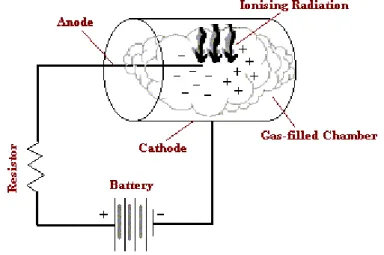
![Figure 2: The electron energy dependence of the dissociative electron attachment cross section of oxygen (experimental data taken from[13])](https://thumb-eu.123doks.com/thumbv2/123dokorg/7288826.85589/7.892.216.720.690.1046/figure-electron-dependence-dissociative-electron-attachment-section-experimental.webp)
